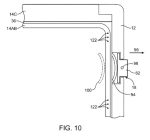While iPhone fans trying to guess what Apple is working on for the next iPhone have posted many wild concepts online showing iPhone 6 designs that featured curved, flexible or wraparound displays (such as the one above), it looks like the iPhone maker is actively studying such a possibility for future models. AppleInsider has discovered an Apple patent that details a wraparound display for future iPhone models, which would help Apple replace the physical mute and volume buttons found on the left side of the iPhone with a touchscreen that would offer multi-purpose buttons, as well as tactile feedback to the user.
Filed in late September 2011 and titled “Electronic devices with sidewall displays” – revealing that Apple has been considering such technology for quite a while – the patent shows that the company is interested in offering even slicker devices in the future that won’t require as many physical buttons as their predecessors.
“Flexible display technologies are available that allow displays to be flexed. For example, flexible displays may be formed using flexible organic light-emitting diode (OLED) display technology,” the patent reads. “It would be desirable to be able to use flexible display technology to provide improved electronic devices such as electronic devices with input-output components.”
Apple has already taken steps to reducing the footprint of the volume buttons on the iPhone 6 – if the many recent leaks that hit the web are to be believed – but they’re still physical. Recent leaks also suggest the company will ditch the square, rigid design lines of existing iPhones in its next models, which are expected to feature curved edges and a slim profile. The move could further pave the way to a smooth transition to an iPhone with a curved, wraparound display in the future.
The patent’s many images show that Apple envisions future iPhones with curved edges, which would allow the touchscreen display to flex around the edges, and offer users quick access to various controls, many more than the mute and volume options offered by current physical buttons on existing iPhone models.
The patent suggests that the virtual buttons could be used to set volume, control music playback, display track information, camera controls, notifications, and other quick information the user may want to glance over. Furthermore, virtual buttons on the edges of the phone could further help users slide-to-unlock their devices, launch other apps, control certain app features and even control games.
“Virtual buttons may include locking and unlocking buttons. Locking and unlocking buttons may be operated using a swipe, pinch, or other touch action by a user of device 10,” Apple writes. “Virtual buttons may include buttons specific to gaming software installed on device 10. For example, virtual buttons may include buttons on edges 24 that may be operated by a user when holding device 10 in a landscape orientation during operation of device 10 in a gaming mode. Virtual buttons may be operated using touch, tap, swipe, pinch or other touch inputs to virtual buttons. Virtual buttons may include buttons commonly provided on a full sized computer keyboard (e.g., caps lock, shift, control, delete, page up/down, number lock, function specific buttons, escape, enter, etc.). Virtual buttons may include buttons commonly found on a calculator (e.g., multiply, add, divide, subtract, memory storage, clear, all clear, percent, square root, or other calculator buttons). Virtual buttons may include buttons for selecting specific software application available on device 10 (e.g., text messaging, calendar, calculator, media player, web browser, email client, cellular telephone, or other software applications). Virtual buttons may include images or icons that indicate the current function of the virtual button. Virtual buttons may include buttons commonly found on cellular telephone such as a menu button, a ringer on/off switch, a ringer on/off/vibrate switch, a lock/unlock button, a call button, an end-call button, or any other button associate with a cellular telephone.”
While the iPhone isn’t clearly specified in the patent, the language and drawings clearly suggest that Apple would primarily use such an invention in a future iPhone model.
However, even though Apple was awarded this particular patent, it’s not clear yet when such an iPhone will actually be released.
So far, only Samsung and LG have released devices with flexible displays, but neither model actually had wraparound displays. Neither model became a hit product either, with reports suggesting that flexible display production isn’t yet at the levels that would allow a company to mass-produce enough supply to meet its demands for flagship devices that would incorporate such features.
More images from the new Apple patent follow below.








